Coretta Scott King called MLK Day “a people’s holiday” but it’s hard to resist honoring the Rev. Dr. Martin Luther King, Jr., who had some of his most important moments here in New York City. Below we’ve summarized King’s relationship to New York in ten vignettes. This article is cross-posted at Untapped Cities, which features a few excellent additional photos.
#1 Blumstein’s Department Store (1958)
In 1958, King traveled to New York to promote his new book about the Montgomery bus boycott, Stride Towards Freedom: The Montgomery Story. The politics of his visit were messy – not only was Harlem in the midst of a competitive election (remarkably, it was then a battleground between New York Democrats and Republicans), but King was met cooly by the NAACP, who now competed with him for donor dollars and found his civil disobedience strategy undignified. (Thurgood Marshall called him “a first-rate rabble rouser.”) Optics were further complicated when King’s people turned down a book signing at a store run by a black nationalist in favor of an upscale white department store, Blumstein’s.
On September 21, at Blumstein’s book signing, a mentally unstable woman stabbed King in the chest with a letter opener, lodging it between his heart and his lungs. King was rushed to Harlem Hospital and underwent a successful operation. It took him several weeks to recover at the hospital and then in Brooklyn, the operation leaving a cross-shaped scar on King’s chest, to which he’d later point with pride.
#2 NYS Civil War Centennial Commission (1962)
King was invited by the New York State Civil War Centennial Commission to deliver a keynote commemorating the 100th anniversary of the Preliminary Emancipation Proclamation, an event organized by Governor Nelson Rockefeller. President Lincoln had issued the Preliminary Emancipation Proclamation as a ten-week warning that he was going to issue the Emancipation Proclamation itself on January 1, 1863, a last chance for Confederate states to rejoin the Union.
King expressed hesitation at participating in Rockefeller’s event, concerned that appearing at a Republican-led event would offend President Kennedy and hurt the progress of civil rights legislation. Rockefeller sealed the deal by pledging funds to rebuild several African-American churches that had been burned in Georgia. Rockefeller was a supporter of civil rights and had pulled the New York delegation out of earlier Civil War Centennial events held in parts of the country that permitted segregation.
On September 12, 1962, at the Park-Sheraton Hotel (now Park Central), King offered a blistering assessment of America’s lack of progress in advancing equal rights for blacks. The “Proclamation of Inferiority,” he claimed, “has contended with the Proclamation of Emancipation, negating its liberating force.” The conditioning by whites to make blacks feel inferior in every walk of life had permeated the black consciousness, King explained, requiring a true Emancipation Proclamation, one that would end segregation in practice and discrimination as a way of life.
Not only did the New York State Museum unearth the only audio recording of this speech, but it also houses the only copy of the Preliminary Emancipation Proclamation handwritten by President Lincoln, originally sold at an auction to support the Union war efforts. The Museum’s video accompanying the speech audio features a scrolling written copy that makes it easier to follow along, including notes where King made late alterations to his prepared remarks.
#3 CCNY Commencement (1963)
At the height of King’s struggles in Birmingham, which included his jailing and a separate bombing attempt on his life, City College of New York President Buell Gallagher invited King to speak at thecollege’s commencement.
The previous evening President Kennedy announced that he would propose civil rights legislation in Congress; LBJ would pass the Civil Rights Act in 1964. Then, the morning King was slated to speak, he found out that NAACP Field Secretary Medgar Evers had been murdered in Mississippi. The air was heavy and intense, as King began by telling the graduates that they would be “moving into a world of catastrophic change and calamitous uncertainty.”
One of those graduates, Matthew Goldstein, became CUNY Chancellor, and 50 years later recalled, “Dr. King was not — in that moment or ever — a Commencement speaker. He was a nearly biblical voice of justice and outrage.” King paid tribute to Evers, who “died in the trenches, on the front line where the issue is now joined between that which our President has called for and the last ditch stand of the segregationists who would prefer to create a bloodbath of violence than to relinquish the deadening status quo.”
The commencement took place at CCNY’s Lewisohn Stadium, an amphitheater on 136th Street that was razed a decade later. In what must have been one of the headiest commencement mornings in New York City history, addresses were given at other college campuses by Peace Corps Director Sargent Shriver, Supreme Court Justice Arthur Goldberg and U.N. Ambassador Adlai Stevenson.
#4 The March on Washington for Jobs and Freedom (1963)
According to Jonathan Gill, author of Harlem, the history of the March on Washington “has never properly acknowledged the essential role that Harlemites including A. Philip Randolph and Bayard Rustin played. History associates the movement with the southern black church, but it was just as much the work of Harlem ex-socialists.” Like many politicians, entrepreneurs and nonprofit leaders, when King came to New York he was often looking for people with money to fund his projects. As he planned his major 1963 civil rights march in Washington, D.C., he realized his efforts might collide with Randolph’s rally against economic inequality. The two joined forces, recognizing the wisdom of connecting the two issues, as King did for the rest of his career. Rustin coined the title, “March on Washington for Jobs and Freedom.”
Rustin was a brilliant organizer, whose genius permeated the unspeakable marginalization he suffered as a black, gay, Quaker, Communist. He served as the main fundraiser and logistical planner for the march, while Randolph used his decades of contacts in the labor and civil rights movement to maintain a fragile peace between camps concerned that the event would be too radical and those that believed it was not radical enough. Less than a week before the march, Tony Bennett (who participated in the march) headlined a fundraiser for the event on a bill that also featured Count Basie and Little Stevie Wonder. It’s good to know that even back in 1963, you could count on New York City to put together a star-studded benefit concert.
#5 Mayor Wagner Honors King with Medallion (1964)
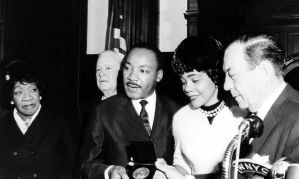 In 1964 King was honored with the Nobel Peace Prize, and New York City offered its congratulations. On December 17, 1964, King was was honored with the City of New York Medallion of Honor at an event in the City Council chambers. Not only were the City’s religious leaders on hand, but the national anthem was played by the Department of Sanitation Band!
In 1964 King was honored with the Nobel Peace Prize, and New York City offered its congratulations. On December 17, 1964, King was was honored with the City of New York Medallion of Honor at an event in the City Council chambers. Not only were the City’s religious leaders on hand, but the national anthem was played by the Department of Sanitation Band!
In bestowing King with the Medallion, Mayor Robert Wagner, Jr. offered, “This is not your city of residence, Dr. King, but it is your city nevertheless… We claim you, henceforth, as an honorary New Yorker.” The Medallion is the highest civilian honor conferred by New York City. The list of recipients is a little haphazard, and it seems to have fallen out of fashion.
During Wagner’s three terms he generally demonstrated a strong commitment to civil rights, but during the past year he had been struggling with demonstrations related to school integration, and he would not run for re-election the following year. WNYC ran a longer piece on the ceremony a few years ago.
#6 New York City Bar Association (1965)
A month after the 1965 March on Selma, King spoke to a capacity crowd at the New York City Bar Association in midtown; more than 500 people crammed the outside of the main meeting hall to listen, and 3,000 more had to be turned away from the building. The City Bar, first organized in 1870 in response to the judicial corruption of Tammany Hall, has always been more liberal than the American Bar Association, which was still murky on civil rights legislation a year after LBJ’s passage of the Civil Rights Act. In fact, King notes in his remarks that this is his first address to any Bar association.
King’s speech was largely effusive in its admiration for lawyers and the legal system, but acknowledged the law’s limitations: “Justice at times proceeds with a halting gait, that at times the law has been slow to speak for the poor, the oppressed, the unpopular, the disfranchised.”
Revisiting a theme that he had explored in his Civil War Centennial address, King lamented that “lawlessness stalks in altogether too many sections of the Southland.” King’s message frames the protested, rather than the protesters, as the culprits disobeying the law- hence the march on Selma, where such few blacks were permitted to register to vote. King was precise and eloquent in contrasting the moral standing of marchers’ disobeying unjust laws and the “lawlessness of the segregationist.”
King also questioned what more needed to be done to enforce laws, given the impotence of post-Brown vs. Board of Education school desegregation efforts. His conclusion that the nation’s 260,000 lawyers (now 1.3 million) had a particular obligation to fight injustice is one that many law schools take to heart rhetorically, even as they remain factories for the corporate sector. King closed with what had become a go-to line that called for further struggle without discounting past victories, “Lord, we ain’t what we ought to be. We ain’t what we want to be. We ain’t what we are going to be. But thank God we ain’t what we was.”
The Bar’s website includes a fascinating question and answer with King after the speech. (pp. 19-23). (http://www.nycbar.org/images/stories/pdfs/Home/mlk.pdf)
#7 Riverside Church (1967)
On April 4, 1967, King delivered “Beyond Vietnam,” one of his most consequential speeches, at the Riverside Church on 121st Street. An utter denunciation of the war in Vietnam and indictment of American imperialism, the speech linked critiques of U.S. foreign and domestic policies. King laments, “We have been repeatedly faced with the cruel irony of watching Negro and white boys on TV screens as they kill and die together for a nation that has been unable to seat them together in the same schools.”
Much of the hour-long sermon is devoted to an exhaustive history of the conflict in Vietnam, including the U.S. government’s refusal to recognize Vietnamese self-determination from France, though the Vietnamese “quoted the American Declaration of Independence in their own document of freedom.” King wonders how we could possibly view ourselves as Vietnam’s “liberators” as we bombed their villages and destroyed their land, a worthy question in light of our more recent overseas adventures. Nor does King acknowledge the framing of the Viet Cong as our enemies, “for no document from human hands can make these humans any less than our brothers.”
Having made clear that he would be satisfied with nothing short of immediate withdrawal from Vietnam, King turns to more universal themes. He hammers America’s growing addiction to materialism, imperialism, and the politics of hate – repeatedly calling for a revolution in values and an end to “poverty, racism, and militarism.”
Like King’s other speeches, “Beyond Vietnam” demands both concrete reforms and a fundamental reevaluation of how we treat each other:
When machines and computers, profit motives and property rights, are considered more important than people, the giant triplets of racism, extreme materialism, and militarism are incapable of being conquered…A true revolution of values will soon look uneasily on the glaring contrast of poverty and wealth… A true revolution of values will lay hand on the world order and say of war, ‘This way of settling differences is not just.’ This business of burning human beings with napalm, of filling our nation’s homes with orphans and widows, of injecting poisonous drugs of hate into the veins of peoples normally humane, of sending men home from dark and bloody battlefields physically handicapped and psychologically deranged, cannot be reconciled with wisdom, justice, and love. A nation that continues year after year to spend more money on military defense than on programs of social uplift is approaching spiritual death.
During his 2008 campaign, Barack Obama frequently cited the “fierce urgency of now,” a phrase King employs during this speech. The tour de force ends with King calling for the day “when justice will roll down like waters, and righteousness like a mighty stream.”
The New York Times blasted King’s “facile” connection between the escalating war in Vietnam and de-escalation of funding for the War on Poverty in an editorial named “Dr. King’s Error.” The specific use of the word “facile” is interesting insofar as King had used the term himself in acknowledging how obvious the connection was! In fact, none other than President Lyndon Johnson drove himself to depression in watching Vietnam soak not only the funds but the political energy to maintain the Great Society programs. Of course, while LBJ believed that privately, he fumed at MLK’s “betrayal” on Vietnam, severing a relationship that previously, contrary to its presentation in the recent movie, Selma, had been one of significant cooperation and amicability. Eerily, King’s sermon at Riverside took place exactly a year before he was killed.
On April 4, Janos.nyc will be running a full piece covering this speech on the site’s Today in NYC History section and include the story of Riverside Church, host to decades of activism, and, incidentally, Janos’ baptism.
#8 Carnegie Hall (1968)
How do you get to Carnegie Hall? For Dr. King, it was the 100th Birthday of W.E.B. Du Bois, a pioneer in the African-American community. The event, held on February 23, 1968, was King’s last address in New York and one of his final public speeches.
As befitting the occasion, the speech is largely a glowing tribute to Du Bois. King focused on Du Bois’ towering intellectual achievements, particularly his deeply researched Black Reconstruction, which “demolished the lies about Negroes in their most important and creative period of history,” and the ease with which he moved through both the highest levels of academic achievement and gritty organizing: “The educated Negro who is not really part of us and the angry militant who fails to organize us have nothing in common with Dr. Du Bois. He exemplified black power in achievement and he organized black power in action. It was no abstract slogan to him.”
King firmly believed that even as organizers must live the struggle, they must always fight with sophistication, unclouded by anger. King had spent his career on this impossible political tightrope, and by 1968 he had lost both his ability to convince young blacks to abandon anger in the face of injustice and access to mainstream political power.
At this radical, lonely twilight of his career, King’s comments about communism may well have led this speech to the archive burial grounds. Some writers (here and here) wonder whether corporate sponsors are responsible for the absence of audio or visual recordings of the speech – apparently even tracking down the text was difficult. Passages like this make you wonder:
We cannot talk of Dr. Du Bois without recognizing that he was a radical all of his life. Some people would like to ignore the fact that he was a Communist in his later years. It is worth noting that Abraham Lincoln warmly welcomed the support of Karl Marx during the Civil War and corresponded with him freely. In contemporary life the English speaking world has no difficulty with the fact that Sean O’Casey was a literary giant of the twentieth century and a Communist or that Pablo Neruda is generally considered the greatest living poet though he also served in the Chilean Senate as a Communist. It is time to cease muting the fact that Dr. Du Bois was a genius and chose to be a Communist. Our irrational, obsessive anti-communism has led us into too many quagmires to be retained as if it were a mode of scientific thinking.
Or perhaps the King Center is not comfortable with his line that “[Du Bois] had to deal with the army of white propagandists – the myth-makers of Negro history. Dr. Du Bois took them all on in battle.” Whatever the mystery behind the missing audio/visual, the text of the speech is revelatory enough.
Janos.nyc will explore this speech in greater detail on February 23 on the site’s Today in NYC History section.
#9 New York Senator Defends MLK Day
New York State has celebrated MLK Day since its inception in 1986. When the U.S. Senate debated the federal holiday in 1983, Jesse Helms (R-NC) filibustered, reciting a statement on King’s opposition to the Vietnam War, “communist associates” and womanizing, and submitting a 300-page supplement to fellow Senators. Daniel Patrick Moynihan (D-NY), declared the document a “packet of filth” and stomped it on the Senate floor. This aide’s entertaining memo also features Knicks legend “Dollar Bill” Bradley (D-NJ) standing up to opponents of the holiday: “I hear their rationalization. They are not against black Americans, you understand. Just Dr. King… They are playing up to Old Jim Crow and all of us know it.” The bill enacting the holiday passed 78-22.
#10 New York City Namesakes
New York City has shown its appreciation and admiration for King in the 47 years since his death. Probably the most well-known King namesake in the City was the Martin Luther King, Jr. High School by Lincoln Center, across from LaGuardia High School. (Obscure historical figures need not apply.) The Bloomberg administration closed the school and reopened it as seven schools in the Martin Luther King, Jr. Educational Campus, as they were wont to do in the era of “school reform.” The school used to house the Fordham Law School intramural basketball league, where you might have seen old Janos playing lockdown defense for the Hung Jurors.
Other City landmarks that bear King’s name include the Martin Luther King, Jr. Towers, a NYCHA complex in East Harlem that houses over 3,000 residents, the Dr. Martin Luther King, Jr. Health Center and Martin Luther King Triangle park space in the Bronx, and Manhattan’s 125th Street, which is co-named Martin Luther King Jr. Boulevard, one of 730 American streets named for King.
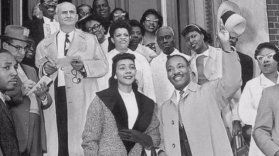
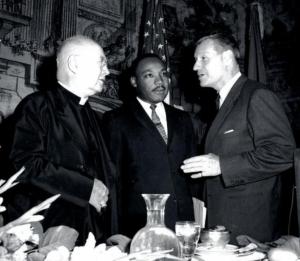
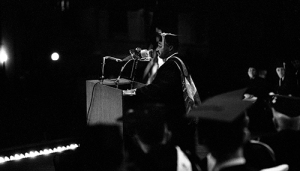
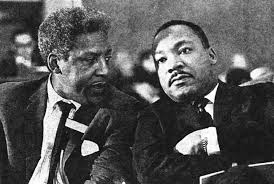
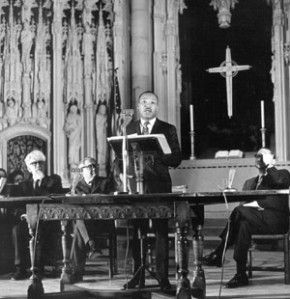
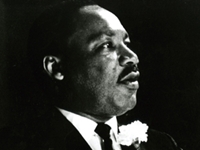
Pingback: Today in NYC History: MLK Gives Stirring Speech at NYC Bar Association | janos.nyc